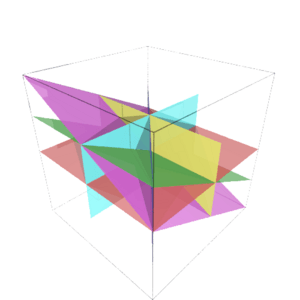Hyperplane arrangements facts for kids
A hyperplane arrangement is a cool idea in mathematics! Imagine you have a big space, like a room. Now, imagine you put flat, thin objects, like sheets of paper, inside that room. These "sheets of paper" are what mathematicians call "hyperplanes." When you put a bunch of these hyperplanes together, they create an "arrangement."
Mathematicians study how these hyperplanes cut up the space and how they cross each other. This field of study is connected to other exciting areas of math, like how numbers work (number theory), counting different ways to arrange things (combinatorics), and studying shapes and spaces (topology).
Contents
What Are Hyperplane Arrangements?
A hyperplane arrangement is a collection of these special "flat" objects called hyperplanes. They are all placed inside a larger space. Think of it like slicing a cake many times. Each slice is a hyperplane, and all the slices together form an arrangement.
What is a Hyperplane?
In simple terms, a hyperplane is like a flat surface that divides a space. Its dimension is always one less than the space it lives in.
- If you are in a 1D space (like a line), a hyperplane is just a single point. This point divides the line into two parts.
- If you are in a 2D space (like a flat piece of paper), a hyperplane is a line. This line divides the paper into two halves.
- If you are in a 3D space (like our world), a hyperplane is a flat plane. This plane divides the space into two parts, like a wall dividing a room.
- Mathematicians also study spaces with more than three dimensions! In those spaces, a hyperplane is still a "flat" object that has one less dimension than the space it's in.
Why Study Hyperplane Arrangements?
Mathematicians study hyperplane arrangements for many reasons. They want to understand:
- How many different regions are created when hyperplanes cut through a space?
- What shapes do these regions have?
- How do the hyperplanes intersect (cross each other)?
- What happens if you move or change one of the hyperplanes?
This field helps us understand patterns and structures in different kinds of spaces. It's like figuring out all the different ways you can cut a pizza with several straight cuts.
Connections to Other Math Fields
The study of hyperplane arrangements is not just about lines and planes. It connects to many other cool parts of mathematics:
- Combinatorics: This is the math of counting. Hyperplane arrangements help count the number of regions or intersections.
- Topology: This is the study of shapes and spaces. Hyperplane arrangements create interesting shapes and spaces that topologists like to explore.
- Algebra: This involves using symbols and equations. Algebra helps describe the hyperplanes and their arrangements.
- Geometry: This is the study of shapes, sizes, and positions of figures. Hyperplane arrangements are a fundamental part of geometry.
Understanding hyperplane arrangements can help solve problems in these other areas of math. It's a way to see how different mathematical ideas are linked together.


